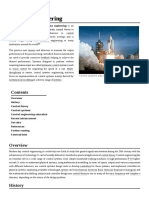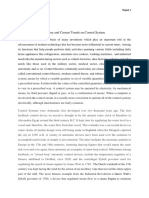0 ratings0% found this document useful (0 votes)
161 viewsControl System
The document introduces the topic of control systems design. It describes control systems as interconnected components designed to achieve a desired purpose. Modern control engineering involves strategies for improving manufacturing processes, energy efficiency, vehicle control and more. The chapter also discusses the "design gap" between real physical systems and simplified models. An iterative design process can effectively address this gap while balancing complexity, performance and cost.
Uploaded by
iekazalyCopyright
© © All Rights Reserved
Available Formats
Download as PPT, PDF, TXT or read online on Scribd
0 ratings0% found this document useful (0 votes)
161 viewsControl System
The document introduces the topic of control systems design. It describes control systems as interconnected components designed to achieve a desired purpose. Modern control engineering involves strategies for improving manufacturing processes, energy efficiency, vehicle control and more. The chapter also discusses the "design gap" between real physical systems and simplified models. An iterative design process can effectively address this gap while balancing complexity, performance and cost.
Uploaded by
iekazalyCopyright
© © All Rights Reserved
Available Formats
Download as PPT, PDF, TXT or read online on Scribd
You are on page 1/ 41
Illustrations
In this chapter we describe a general process for designing a control system.
A control system consisting of interconnected components is designed to achieve a
desired purpose. To understand the purpose of a control system, it is useful to
examine examples of control systems through the course of history. These early
systems incorporated many of the same ideas of feedback that are in use today.
Modern control engineering practice includes the use of control design strategies for
improving manufacturing processes, the efficiency of energy use, advanced
automobile control, including rapid transit, among others.
We also discuss the notion of a design gap. The gap exists between the complex
physical system under investigation and the model used in the control system
synthesis.
The iterative nature of design allows us to handle the design gap effectively while
accomplishing necessary tradeoffs in complexity, performance, and cost in order to
meet the design specifications.
Chapter 1: Introduction to Control Systems
Objectives
Illustrations
Introduction
System An interconnection of elements and devices for a desired purpose.
Control System An interconnection of components forming a system
configuration that will provide a desired response.
Process The device, plant, or system
under control. The input and output
relationship represents the cause-and-
effect relationship of the process.
Illustrations
Introduction
Multivariable Control System
Open-Loop Control Systems
utilize a controller or control
actuator to obtain the desired
response.
Closed-Loop Control
Systems utilizes feedback to
compare the actual output to
the desired output response.
Illustrations
History
Watts Flyball Governor
(18
th
century)
Greece (BC) Float regulator mechanism
Holland (16
th
Century) Temperature regulator
Illustrations
History
Water-level float regulator
Illustrations
History
Illustrations
History
18th Century James Watts centrifugal governor for the speed control of a steam
engine.
1920s Minorsky worked on automatic controllers for steering ships.
1930s Nyquist developed a method for analyzing the stability of controlled systems
1940s Frequency response methods made it possible to design linear closed-loop
control systems
1950s Root-locus method due to Evans was fully developed
1960s State space methods, optimal control, adaptive control and
1980s Learning controls are begun to investigated and developed.
Present and on-going research fields. Recent application of modern control theory
includes such non-engineering systems such as biological, biomedical, economic and
socio-economic systems
???????????????????????????????????
Illustrations
(a) Automobile
steering control
system.
(b) The driver uses
the difference
between the actual
and the desired
direction of travel
to generate a
controlled adjustment
of the steering wheel.
(c) Typical direction-
of-travel response.
Examples of Modern Control Systems
Illustrations
Examples of Modern Control Systems
Illustrations
Examples of Modern Control Systems
Illustrations
Examples of Modern Control Systems
Illustrations
Examples of Modern Control Systems
Illustrations
Examples of Modern Control Systems
Illustrations
Examples of Modern Control Systems
Illustrations
Examples of Modern Control Systems
Illustrations
Examples of Modern Control Systems
Illustrations
The Future of Control Systems
Illustrations
The Future of Control Systems
Illustrations
Control System Design
Illustrations
Illustrations
Design Example
Illustrations
ELECTRIC SHIP CONCEPT
Ship
Service
Power
Main Power
Distribution
Propulsion
Motor
Motor
Drive
Generator
Prime
Mover
Power
Conversion
Module
Electric Drive
Reduce # of Prime
Movers
Fuel savings
Reduced maintenance
Technology
Insertion
Warfighting
Capabilities
Vision
Integrated
Power
System
All
Electric
Ship
Electrically
Reconfigurable
Ship
Reduced manning
Automation
Eliminate auxiliary
systems (steam,
hydraulics, compressed
air)
Increasing Affordability and Military Capability
Design Example
Illustrations
CVN(X) FUTURE AIRCRAFT CARRIER
Design Example
Illustrations
Design Example
EMALS
Illustrations
Design Example
Illustrations
Design Example
Illustrations
Design Example
Illustrations
Design Example
Illustrations
Illustrations
Illustrations
Design Example
Illustrations
Design Example
Illustrations
Sequential Design Example
Illustrations
Illustrations
Sequential Design Example
Illustrations
Illustrations
Illustrations
Mistakes
Challenger
Tacoma Bridge
Illustrations
References, and Resources
http://www.ieeecss.org/siteindex/SITEindex.html
http://www-control.eng.cam.ac.uk/extras/Virtual_Library/Control_VL.html
Illustrations
Exercises and Problems
Illustrations
Exercises and Problems
You might also like
- Bjectives: Chapter 1: Introduction To Control Systems ONo ratings yetBjectives: Chapter 1: Introduction To Control Systems O41 pages
- Bjectives: Chapter 1: Introduction To Control Systems ONo ratings yetBjectives: Chapter 1: Introduction To Control Systems O41 pages
- Bjectives: Chapter 1: Introduction To Control Systems ONo ratings yetBjectives: Chapter 1: Introduction To Control Systems O41 pages
- Brainkart_207 - IC8451, IC6501 Control Systems - Notes.binNo ratings yetBrainkart_207 - IC8451, IC6501 Control Systems - Notes.bin329 pages
- Introduction To Control Systems:ObjectivesNo ratings yetIntroduction To Control Systems:Objectives34 pages
- Control Theories Commonly Used Today Are Classical Control TheoryNo ratings yetControl Theories Commonly Used Today Are Classical Control Theory12 pages
- Control Theory - Wikipedia, The Free EncyclopediaNo ratings yetControl Theory - Wikipedia, The Free Encyclopedia14 pages
- 1 - Introduction To Control Chapter OneNo ratings yet1 - Introduction To Control Chapter One13 pages
- Hệ thống Điều khiển tự động: (Automatic control systems)No ratings yetHệ thống Điều khiển tự động: (Automatic control systems)235 pages
- Control System Engineering: InstructorsNo ratings yetControl System Engineering: Instructors49 pages
- Simulation of Some Power System, Control System and Power Electronics Case Studies Using Matlab and PowerWorld SimulatorFrom EverandSimulation of Some Power System, Control System and Power Electronics Case Studies Using Matlab and PowerWorld SimulatorNo ratings yet
- A Review on the Utilization of Reinforcement Learning and Artificial Intelligence Techniques for Buildings Heating, Ventilation, and Air Conditioning Automation System: building industry, #0From EverandA Review on the Utilization of Reinforcement Learning and Artificial Intelligence Techniques for Buildings Heating, Ventilation, and Air Conditioning Automation System: building industry, #0No ratings yet
- Advanced Dynamic-System Simulation: Model Replication and Monte Carlo StudiesFrom EverandAdvanced Dynamic-System Simulation: Model Replication and Monte Carlo StudiesNo ratings yet
- Methods for Increasing the Quality and Reliability of Power System Using FACTS DevicesFrom EverandMethods for Increasing the Quality and Reliability of Power System Using FACTS DevicesNo ratings yet
- Discrete Event Systems in Dioid Algebra and Conventional AlgebraFrom EverandDiscrete Event Systems in Dioid Algebra and Conventional AlgebraNo ratings yet
- Advancements in Mechanical Engineering: Innovating at the Convergence of TechnologiesFrom EverandAdvancements in Mechanical Engineering: Innovating at the Convergence of TechnologiesNo ratings yet
- New Directions in Dynamical Systems, Automatic Control and Singular PerturbationsFrom EverandNew Directions in Dynamical Systems, Automatic Control and Singular PerturbationsNo ratings yet
- Control of DC Motor Using Different Control StrategiesFrom EverandControl of DC Motor Using Different Control StrategiesNo ratings yet
- Integration of Green and Renewable Energy in Electric Power SystemsFrom EverandIntegration of Green and Renewable Energy in Electric Power SystemsNo ratings yet
- System Dynamics: Modeling, Simulation, and Control of Mechatronic SystemsFrom EverandSystem Dynamics: Modeling, Simulation, and Control of Mechatronic Systems1/5 (1)
- Tutorial 7 Matrix Algebra For Homogeneous Linear Algebraic SystemNo ratings yetTutorial 7 Matrix Algebra For Homogeneous Linear Algebraic System3 pages
- Powder Metallurgy For 2025 & 2026 GATE ESE PSUs by S K MondalNo ratings yetPowder Metallurgy For 2025 & 2026 GATE ESE PSUs by S K Mondal13 pages
- Contingency Perspectives of Organizational Strategy - A Critical Review of The Empirical ResearchNo ratings yetContingency Perspectives of Organizational Strategy - A Critical Review of The Empirical Research15 pages
- Quantitative Aptitude Sample Paper 1 PDFNo ratings yetQuantitative Aptitude Sample Paper 1 PDF9 pages
- Overlapnet: Loop Closing For Lidar-Based SlamNo ratings yetOverlapnet: Loop Closing For Lidar-Based Slam10 pages
- 22nd - 25th Oct Consolidated - Seating - Plan - Morning - ShiftNo ratings yet22nd - 25th Oct Consolidated - Seating - Plan - Morning - Shift4 pages
- Cryptographic Algorithm Validation ProgramNo ratings yetCryptographic Algorithm Validation Program21 pages
- Bjectives: Chapter 1: Introduction To Control Systems OBjectives: Chapter 1: Introduction To Control Systems O
- Bjectives: Chapter 1: Introduction To Control Systems OBjectives: Chapter 1: Introduction To Control Systems O
- Bjectives: Chapter 1: Introduction To Control Systems OBjectives: Chapter 1: Introduction To Control Systems O
- Brainkart_207 - IC8451, IC6501 Control Systems - Notes.binBrainkart_207 - IC8451, IC6501 Control Systems - Notes.bin
- Control Theories Commonly Used Today Are Classical Control TheoryControl Theories Commonly Used Today Are Classical Control Theory
- Hệ thống Điều khiển tự động: (Automatic control systems)Hệ thống Điều khiển tự động: (Automatic control systems)
- Simulation of Some Power System, Control System and Power Electronics Case Studies Using Matlab and PowerWorld SimulatorFrom EverandSimulation of Some Power System, Control System and Power Electronics Case Studies Using Matlab and PowerWorld Simulator
- Control of Non-conventional Synchronous MotorsFrom EverandControl of Non-conventional Synchronous Motors
- A Review on the Utilization of Reinforcement Learning and Artificial Intelligence Techniques for Buildings Heating, Ventilation, and Air Conditioning Automation System: building industry, #0From EverandA Review on the Utilization of Reinforcement Learning and Artificial Intelligence Techniques for Buildings Heating, Ventilation, and Air Conditioning Automation System: building industry, #0
- Advanced Dynamic-System Simulation: Model Replication and Monte Carlo StudiesFrom EverandAdvanced Dynamic-System Simulation: Model Replication and Monte Carlo Studies
- Advanced Control of Aircraft, Spacecraft and RocketsFrom EverandAdvanced Control of Aircraft, Spacecraft and Rockets
- Methods for Increasing the Quality and Reliability of Power System Using FACTS DevicesFrom EverandMethods for Increasing the Quality and Reliability of Power System Using FACTS Devices
- Discrete Event Systems in Dioid Algebra and Conventional AlgebraFrom EverandDiscrete Event Systems in Dioid Algebra and Conventional Algebra
- Advancements in Mechanical Engineering: Innovating at the Convergence of TechnologiesFrom EverandAdvancements in Mechanical Engineering: Innovating at the Convergence of Technologies
- Aerodynamics Unlocked: From Fundamentals to Future FlightFrom EverandAerodynamics Unlocked: From Fundamentals to Future Flight
- Control System: Fundamentals and ApplicationsFrom EverandControl System: Fundamentals and Applications
- New Directions in Dynamical Systems, Automatic Control and Singular PerturbationsFrom EverandNew Directions in Dynamical Systems, Automatic Control and Singular Perturbations
- Control of DC Motor Using Different Control StrategiesFrom EverandControl of DC Motor Using Different Control Strategies
- Introduction to Hybrid Vehicle System Modeling and ControlFrom EverandIntroduction to Hybrid Vehicle System Modeling and Control
- Engineering a Safer World: Systems Thinking Applied to SafetyFrom EverandEngineering a Safer World: Systems Thinking Applied to Safety
- Integration of Green and Renewable Energy in Electric Power SystemsFrom EverandIntegration of Green and Renewable Energy in Electric Power Systems
- System Dynamics: Modeling, Simulation, and Control of Mechatronic SystemsFrom EverandSystem Dynamics: Modeling, Simulation, and Control of Mechatronic Systems
- Tutorial 7 Matrix Algebra For Homogeneous Linear Algebraic SystemTutorial 7 Matrix Algebra For Homogeneous Linear Algebraic System
- Powder Metallurgy For 2025 & 2026 GATE ESE PSUs by S K MondalPowder Metallurgy For 2025 & 2026 GATE ESE PSUs by S K Mondal
- Contingency Perspectives of Organizational Strategy - A Critical Review of The Empirical ResearchContingency Perspectives of Organizational Strategy - A Critical Review of The Empirical Research
- 22nd - 25th Oct Consolidated - Seating - Plan - Morning - Shift22nd - 25th Oct Consolidated - Seating - Plan - Morning - Shift

























































































